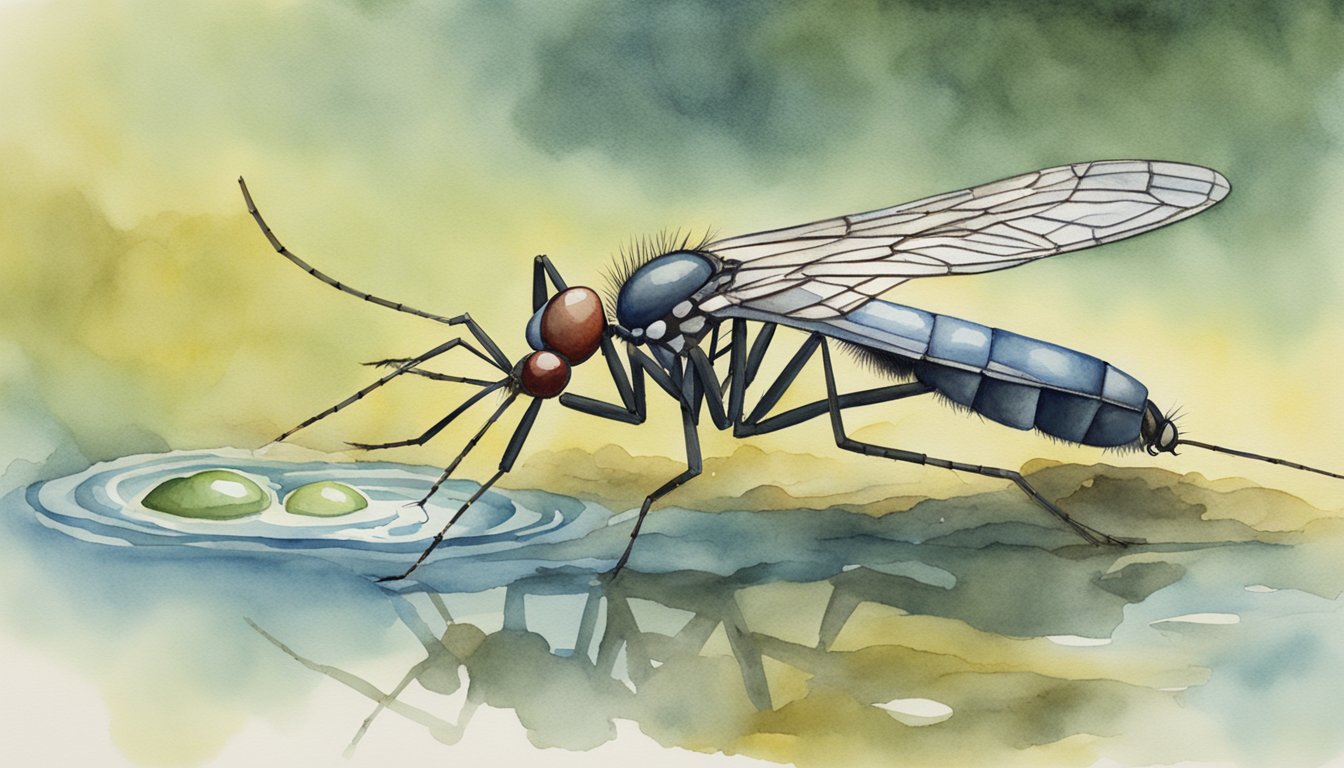Understanding Mosquito Biology
Exploring the world of mosquitoes unveils a complex life cycle and surprising adaptations that allow these small but mighty creatures to thrive across the globe.
Life Cycle and Reproduction
Mosquitoes undergo a fascinating metamorphosis through their life cycle, starting from eggs laid on stagnant water surfaces. Female mosquitoes lay their eggs, which hatch into aquatic larvae, wriggling creatures that feed on organic matter. The larvae molt several times before becoming pupae, a transitional stage where they don’t feed but transform into adult mosquitoes. Adult males typically emerge first and wait to mate with the emerging females. Once mating occurs, females seek a blood meal to nourish their eggs, completing their reproductive cycle.
Dietary Patterns of Mosquitoes
While female mosquitoes are notorious for their blood-sucking habits, required for egg development, it’s a little-known fact that both male and female mosquitoes also feed on nectar for daily energy. The female’s proboscis—a specialized feeding apparatus—is designed for piercing skin and siphoning blood, which contains the necessary proteins and iron to produce eggs.
Physical Characteristics and Adaptations
Mosquitoes possess an array of physical traits well-suited to their lifestyle. With a lightweight exoskeleton, they can easily alight on water without sinking. Their wings are capable of beating 300 to 600 times per second, making them expert flying insects. Moreover, their proboscis not only draws blood but can also detect chemicals in the environment, leading them to their next meal. Diverse mosquito species have adapted to environments from tropical forests to arctic tundra, showcasing their resilient nature.
Mosquitoes in the Ecosystem

In exploring the role of mosquitoes within various ecosystems, it’s essential to recognize their impact on pollination, their place in the food web as prey, and their infamous status as vectors for numerous diseases.
Pollination and Plant Interactions
Although they’re not as renowned as bees or butterflies for their pollination services, mosquitoes do contribute to the process. They frequently feed on nectar, the sweet liquid produced by plants, which contains the sugars mosquitoes need for energy. During these feeding sessions, some mosquito species inadvertently carry pollen from one flower to another, aiding in plant reproduction. This interaction highlights an often overlooked aspect of mosquitoes’ ecological role.
Mosquitoes as Prey
Mosquitoes serve as a crucial food source within the food web. A wide array of wildlife, including birds, fish, frogs, bats, turtles, and spiders, depend on mosquitoes for nourishment. Both adult mosquitoes and their larvae are consumed by various predators, indicating their vital contribution to ecosystem balance. If mosquitoes were removed, these animals might struggle to find alternative food sources, potentially disrupting the ecological equilibrium.
The Role of Mosquitoes as Disease Vectors
Despite their role in pollination and as prey, mosquitoes are best known as vectors for diseases such as malaria, dengue, yellow fever, and encephalitis. These diseases occur when an infected mosquito bites a host, passing along pathogens. This aspect of their existence poses a significant challenge for mosquito control efforts and underscores the complexity of their role in both supporting and threatening life in ecosystems.
Human and Mosquito Interactions

Mosquitoes are often seen as pesky bloodsuckers, but their interactions with humans go beyond the nuisance of itchy bites. These tiny insects play a significant role in public health, either by their capability to transmit diseases or through the methods humans use to manage their populations.
Health Impacts of Mosquitoes
The most immediate effect mosquitoes have on people is the itchy and often swollen bite marks they leave behind. This discomfort is caused by an allergic reaction to mosquito saliva, which the insect injects to prevent blood clotting. However, it’s the potential of mosquitoes to transmit viruses such as dengue fever, Zika, and West Nile virus that leads to severe health concerns. Each of these diseases can have lasting impacts on human populations, sometimes resulting in significant morbidity and, in some cases, mortality.
- Dengue Fever: A flu-like illness that can develop into severe complications like hemorrhagic fever.
- Zika Virus: Known to cause birth defects if pregnant women are infected.
- West Nile Virus: Can lead to life-threatening conditions like encephalitis or meningitis.
These virus-mosquito interactions are critical to understanding viral emergence and necessitate close monitoring and management.
Mosquito Management and Control
Controlling mosquito populations is a major public health effort, embracing practices from individual protective measures to community-wide initiatives. Residential mosquito spray companies offer services to reduce the numbers of these pests, often employing broad-spectrum insecticide sprays. These sprays can sometimes be a controversial control method due to their potential environmental impacts. Nonetheless, they are part of an integrated approach, which also includes:
- Larval Control: Addressing mosquitoes at their water-borne developmental stage to stop the lifecycle.
- Heartworm Prevention: Protecting pets through medications, as mosquitoes are vectors for this disease.
Mosquito management isn’t just about eradication; it’s a delicate balance that aims to protect human health while considering ecological consequences. The study of interactions such as Flavivirus-mosquito relationships helps guide smarter control strategies that could be more sustainable and targeted.

